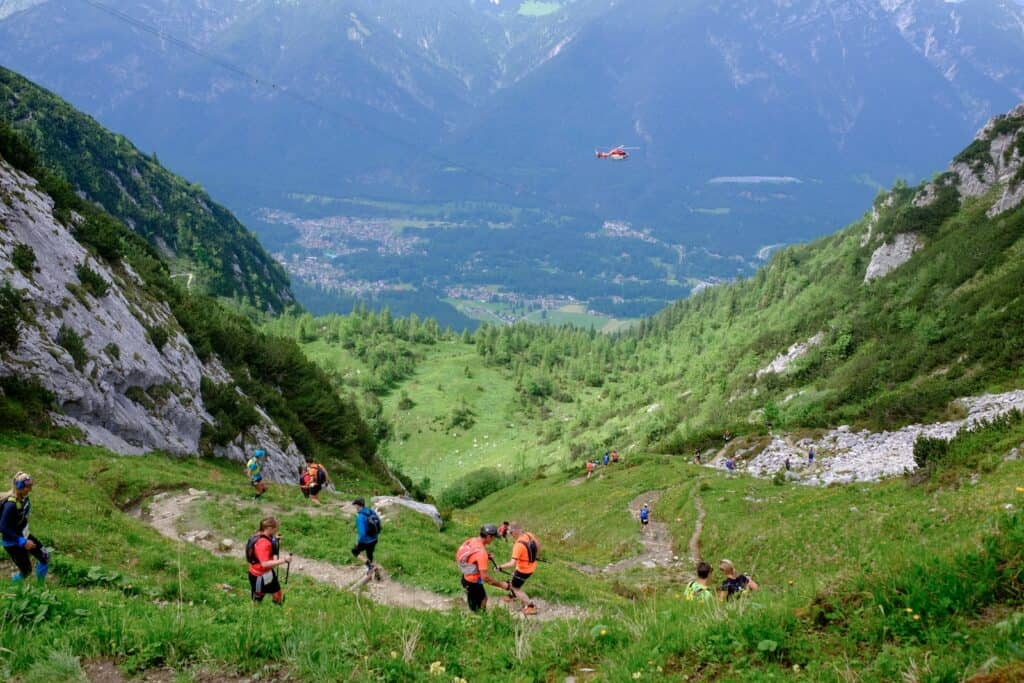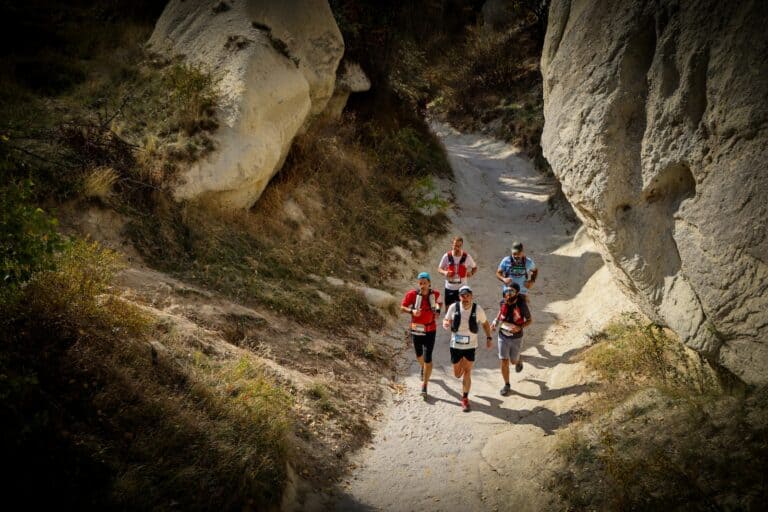Have you ever wondered, “what is trail running?” If so, you’re not alone. Trail running has become increasingly popular in recent years, with more and more people seeking a connection with nature, a break from the monotony of road running, and a unique physical challenge. In this blog post, we’ll explore what trail running is, its benefits, how to get started, and tips for improving your performance. We’ll also discuss trail running shoes, races, and local trails to help you dive into this exciting sport.
What is Trail Running?

Trail running is a sport that involves running on natural, uneven terrain such as dirt trails, gravel roads, hiking trails, and mountainous terrain. It combines elements of road running, hiking, and sometimes even mountain running, requiring trail runners to navigate through various trail features like roots, rocks, and elevation gain. Unlike road running, which typically occurs on paved roads and more consistent surfaces, trail running offers a more dynamic and challenging experience due to the varied and often rough terrain.
The history of trail running can be traced back to the early days of human civilization when our ancestors relied on running as a means of hunting and gathering food. However, it wasn’t until the 20th century that trail running began to emerge as a popular recreational activity and competitive sport. Today, there are countless trail running races, clubs, and associations worldwide, catering to all levels of experience, from beginners to elite athletes.
Differences Between Trail Running and Road Running

There are several key differences between trail running and road running, which contribute to the unique challenge and appeal of the sport.
Terrain
The most obvious difference between trail running and road running is the terrain. Trail running typically takes place on uneven terrain, such as dirt trails, rocky paths, and steep inclines, while road running occurs on relatively flat, paved surfaces. This difference in terrain requires trail runners to adapt their running style, paying closer attention to foot placement, and developing greater agility and balance.
Pace
Due to the challenging terrain, trail running generally involves a slower pace than road running. Factors such as elevation gain, technical terrain, and the need to navigate obstacles often require trail runners to walk or hike certain sections of a trail run, especially for longer distances. However, experienced trail runners can still maintain a relatively fast running pace on less technical trails.
Footwear
Trail running shoes are designed specifically for off-road running and provide better traction, foot protection, and support than road running shoes. Many trail running shoes feature aggressive outsoles for grip on rocky and slippery surfaces, rock plates for underfoot protection, and more durable, supportive uppers. While some runners may attempt to use road running shoes for trail running, it’s generally recommended to invest in a pair of specialized trail shoes for the best performance and safety.
Mental Aspects
Trail running often requires a different mindset than road running. The varied terrain and slower pace can be mentally challenging, requiring runners to focus on their surroundings, adjust their expectations, and embrace the unpredictable nature of the sport. Many trail runners find this mental aspect to be one of the most fulfilling and enjoyable parts of trail running.
Benefits of Trail Running

There are numerous benefits to trail running, ranging from physical improvements to mental well-being.
Physical Benefits
1. Improved balance and coordination: Navigating uneven terrain and obstacles during a trail run helps to develop better balance and coordination, which can translate to improved performance in other sports and everyday activities.
2. Strengthening of different muscle groups: Trail running engages a wider variety of muscle groups than road running, particularly in the lower body and core. This can lead to a more well-rounded and balanced level of fitness.
3. Reduced impact on joints: Running on softer, natural surfaces like dirt trails and grass can help to reduce the impact on joints compared to the harder surfaces of paved roads. This can potentially lower the risk of injury and promote long-term joint health.
Mental Benefits
1. Connection with nature: One of the most significant appeals of trail running is the opportunity to connect with nature, escape from the hustle and bustle of daily life, and enjoy the fresh air and scenic surroundings. Many trail runners find this aspect to be incredibly rejuvenating and therapeutic.
2. Reduced stress levels: The combination of physical exercise, fresh air, and immersion in nature has been shown to reduce stress levels and promote overall mental well-being.
3. Improved self-confidence and problem-solving skills: Successfully navigating challenging terrain and overcoming obstacles during a trail run can lead to a sense of accomplishment and increase self-confidence. Additionally, trail running often requires quick decision-making and adaptability, helping to develop problem-solving skills.
Social Benefits
1. Community aspect: Trail running has a strong sense of community, with numerous running clubs, groups, and events catering to all levels of experience. These groups often provide a supportive and welcoming environment for both beginners and experienced runners.
2. Supportive environment: Trail runners are often known for their camaraderie and encouragement, helping each other to overcome challenges and reach their goals.
3. New friendships: Joining a trail running group or participating in trail running races can lead to new friendships and shared experiences, fostering a sense of belonging and social connection.
How to Get Started with Trail Running
Finding Local Trails
The first step in getting started with trail running is to find local trails suitable for your experience level and preferences. Some resources for finding trails include:

1. Online trail databases and mapping tools
2. Local trail running associations and clubs
3. Friends or fellow runners who are familiar with the area
4. Hiking guidebooks or maps
5. Local parks and recreation departments
When starting out, it’s essential to choose trails that match your current fitness level and gradually progress to more challenging terrain as you gain experience and confidence.
Choosing Appropriate Footwear
Investing in a good pair of trail running shoes is crucial for both performance and safety. When selecting trail running shoes, consider the following factors:
1. Traction: Look for shoes with aggressive outsoles and lug patterns for grip on various surfaces, including mud, rocks, and roots.
2. Protection: Many trail running shoes feature rock plates or other protective elements in the midsole to shield the foot from sharp rocks and other trail hazards.
3. Support and stability: Trail running shoes should provide adequate support and stability to help prevent ankle rolls and other injuries on uneven terrain.
4. Fit and comfort: As with any running shoe, it’s essential to find a trail shoe that fits your foot shape and feels comfortable during a run.
It’s worth noting that personal preference plays a significant role in choosing the right trail running shoe, so don’t be afraid to try on multiple pairs and brands to find the best fit for you.
Planning Your Route and Being Prepared
Before heading out for a trail run, it’s essential to plan your route, know the trail features, and be prepared for any potential challenges. Some tips for planning a successful trail run include:

1. Researching the trail, including distance, elevation gain, and technical difficulty
2. Checking the weather forecast and dressing appropriately, including lightweight knit fabrics for warm weather or a lightweight rain shell for wet conditions
3. Informing someone of your planned route and estimated return time
4. Carrying a map, GPS watch, or smartphone with a mapping app for navigation
5. Familiarizing yourself with local wildlife and plants to avoid any potential dangers
Safety Tips for Trail Running
To ensure a safe and enjoyable trail running experience, consider the following safety tips:
1. Start slow and gradually increase your distance and difficulty level as you become more comfortable with trail running.
2. Carry a first aid kit, including band-aids, blister care, and any personal medications, as well as a whistle for emergencies.
3. Stay well-hydrated by carrying a handheld water bottle, hydration pack, or waist pack with a water bottle.
4. Be mindful of your footing and slow down on technical terrain to reduce the risk of injury.
5. Be prepared for sudden weather changes by carrying a lightweight rain shell, hat, and gloves, especially in mountainous terrain.
Joining a Trail Running Group or Club
One of the best ways to get started with trail running is to join a local trail running group or club. These organizations can provide valuable resources, such as group runs, training tips, and information on local trails and events. Additionally, running with a group can offer motivation, camaraderie, and a sense of safety, especially for beginners.
Tips for Improving Trail Running Performance
Whether you’re a beginner or an experienced trail runner, there are several ways to enhance your trail running performance and enjoyment.
Incorporating Hill Training
Hill training is essential for improving your strength, power, and endurance on the trails. Incorporating both uphill and downhill running into your training regimen can help you become more comfortable and efficient on challenging terrain.
Focusing on Agility and Balance Exercises
Agility and balance are crucial for navigating uneven terrain and obstacles during a trail run. Incorporating exercises like plyometrics, single-leg balance drills, and core strengthening into your training routine can help improve your overall stability and coordination on the trails.
Building Endurance through Long Runs
Gradually increasing your long run distance can help build the endurance necessary for tackling longer trail races and events. Be sure to adjust your pace and allow for walking or hiking breaks as needed, especially on more technical or steep sections of the trail.
Practicing Good Running Form
Maintaining proper running form is essential for efficient and injury-free trail running. Key elements of good running form include keeping your head up, shoulders relaxed, arms swinging naturally, and maintaining a slight forward lean from the ankles.
Listening to Your Body and Adjusting Your Pace
Trail running often requires a more intuitive approach to pacing, as factors like elevation gain, technical terrain, and weather conditions can significantly impact your perceived effort and running pace. It’s essential to listen to your body and adjust your pace accordingly, allowing for walking or hiking breaks as needed.
Trail Running Races and Events

.Trail running races offer a fun and competitive way to challenge yourself and connect with fellow trail runners. There are various types of trail races, ranging from short-distance events to ultra marathons, and they often take place in beautiful and remote locations.
Different Types of Trail Races
Trail races can vary significantly in distance, terrain, and difficulty level. Some common types of trail races include:
1. Short-distance trail races (5K to 10K)
2. Mid-distance trail races (half marathon to marathon)
3. Ultra marathons (50K and beyond)
4. Mountain running races (with significant elevation gain and technical terrain)
5. Stage races (multi-day events with varying distances)
Popular Trail Running Events Worldwide
There are countless trail running races worldwide, catering to all levels of experience and interests. Some popular races and events include:
1. Western States 100 Mile Endurance Run (USA)
2. Ultra-Trail du Mont-Blanc (France, Italy, Switzerland)
3. Marathon des Sables (Morocco)
4. The North Face Endurance Challenge Series (USA, Canada)
5. Skyrunning World Series (various locations)
Tips for Preparing for Your First Trail Race
If you’re planning to participate in your first trail race, consider the following tips to help ensure a successful and enjoyable experience:
1. Choose a race that aligns with your current fitness level and trail running experience.
2. Familiarize yourself with the race course, including terrain, elevation gain, and aid station locations.
3. Train on similar terrain and conditions to those you’ll encounter during the race.
4. Practice proper hydration and nutrition strategies during your training runs.
5. Prepare a race-day checklist, including gear, clothing, and other essentials.
Final Thoughts
Trail running offers a unique and rewarding experience for both beginners and experienced runners alike. By understanding the differences between trail running and road running, choosing the right trail running shoes, and following safety guidelines, you can enjoy the many benefits of this exciting sport. With countless local trails, trail running races, and supportive communities, there’s never been a better time to hit the trails and discover the joys of trail running for yourself.
- What Exercises Improve Trail Running
- What Is A Good Trail Running Pace
- What Is A Recovery Run
- What Is Different About Trail Running Shoes
- What Is Technical Trail Running
- What Is The Best Dog Breed For Trail Running
- What Is The Difference Between Running And Trail Running Shoes
- What Is The Most Iconic Trail Running Race
- What Is Trail Running
- What Size Hydration Pack Do I Need
- What To Eat Before Trail Running
- What To Eat During Trail Running Revealed
- What To Wear For Cold Weather Trail Running
- What To Wear For Trail Running The Essentials You Need
